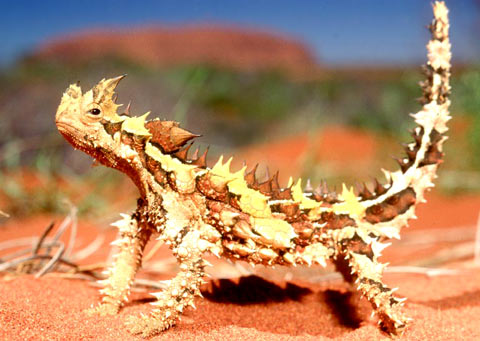
|
Search JoyZine with Google Site Search! |
Lepidosauria
The world of the Triassic Period (248-206 MYA) was a very different place than the later periods of the Mesozoic. The climate was generally hot and dry, with plant communities dominated by seed-ferns. Eastern Australia seemed to be an exception to the generally dry conditions, with swamps and waterways that would eventually turn into the abundant coal deposits of Queensland and New South Wales. Dinosaurs were a minor component of the terrestrial fauna, only diversifying at the very end of the Triassic. Thecodonts were the top predators on land: crocodile-like quadrupeds with enormous heads filled with sharp teeth. They were probably direct ancestors of the dinosaurs themselves. Mammal-like reptiles were the most common types of large land animal, making up to 85% of fossils in some locations. It was a time when the dinosaurs lived in the shadow of other more successful animals—much as us mammals were over-shadowed by dinosaurs in the Jurassic and Cretaceous Periods. In most of Gondwana during the Triassic, reptiles were the dominant form of life on land. In Australia however, Triassic fossils are dominated by amphibians, with reptiles a rare component of the fossil record. Almost all of Australia's Triassic reptiles, and indeed Triassic fossils in general, come from a site known as The Crater, close to Carnarvon National Park in south-central Queensland. These deposits, known as the Arcadia Formation, are a thick sequence of sandstones and mudstones that formed in freshwater pools, lakes and streams around 230 MYA. In most places these soft deposits have weathered to form a thick layer of soil, however in a few areas the intact rocks form brilliantly coloured layers in hues of red, orange, dark brown and purple. Most fossil material found in these layers are badly worn scraps that are difficult to identify. In fact, a lot of the fossil scraps are discovered in coprolites; the fossilised dung of the larger carnivorous animals that lived in the area. Many people think of dinosaurs and other extinct reptiles as just giant lizards. However, lizards belong to a very specific type of reptile: the lepidosaurs. Given their usually small size and delicate nature, lepidosaur fossils are relatively rare when compared with the larger dinosaurs, thecodonts, and mammal-like reptiles. Kudnu mackinlayi Bartholomai 1979 MEANING Lizard-man from Aboriginal mythology CLASSIFICATION Lepidosauria is a superorder of Sauropsida and comprises the orders Squamata, Spehnodontia and Rhynchocophalia. AGE Early Triassic (230 MYA) FORMATION Arcadia Formation, Rewan Group SIZE c.20cm (8 inches) in length LOCATION The Crater (72km SW of Rolleston, S.Central Qld) Kudnu may have been a lepidosaur, a group which includes modern lizards and snakes. Paliguanids are the earliest known types of lizard, and rarely exceeded 15cm in total length. Kudnu is known from a partial skull preserved in a red mudstone nodule from The Crater in south-central Queensland. The name comes from an aboriginal word for a mythical lizard-man. Other possible lepidosaur remains have also been found in the same area, but have not been described in detail. |
